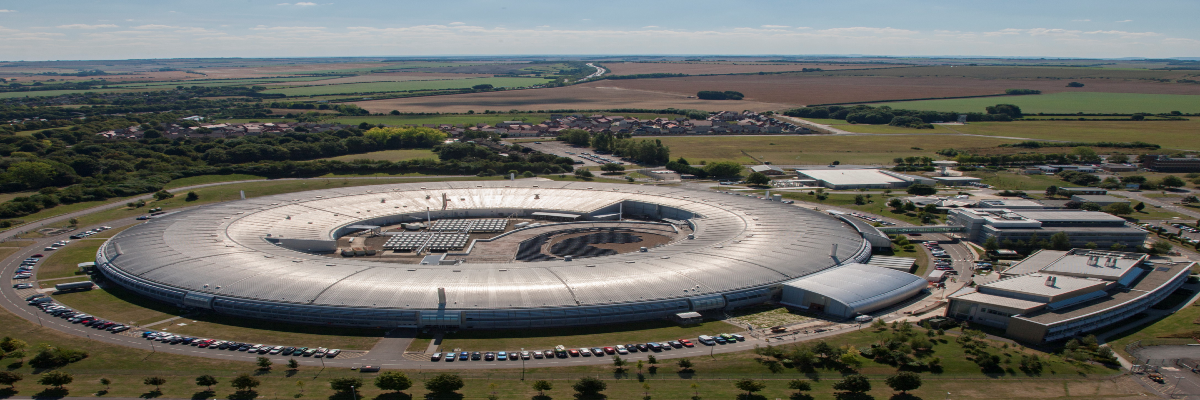FST BLOG
Delivering £1.8 billion in benefits at Diamond Light Source
- 7 June 2021
- Technology
- Isabelle Boscaro-Clarke

Nature is our kindest friend and best critic in experimental science if we only allow her intimations to fall unbiased on our minds. Nothing is so good as an experiment which, whilst it sets an error right, gives us an absolute advancement in knowledge.
Michael Faraday, Experimental Researches in Electricity, Vol. 2 (1834) p. 257.
I love this quote from Faraday as it describes very well what a place like Diamond Light Source achieves - as a laboratory, our experiments make knowledge leap forward.
I spent most of my career working for national laboratories and I have seen first-hand the knowledge power they deliver. Set-up as a not-for-profit company back in March 2002, Diamond is funded by the United Kingdom Research Innovation’s Science and Technology Facilities Council (STFC) and the Wellcome Trust each respectively owning 86% and 14% of the shareholding. From the start, the joint venture enabled a dynamic and agile environment to deliver the UK’s national Synchrotron Light Source on time, on budget and within specifications.
At Diamond we provide researchers from academia and industry with access to state-of-the-art analytical tools to enable world-changing science. Matching the footprint of Wembley stadium, Diamond works like a giant microscope, accelerating electrons to near light speeds, to produce a light 10 billion times brighter than the Sun, which is then directed off into 33 laboratories known as ‘beamlines’. In addition to these, Diamond offers access to several integrated laboratories including the world-class Electron Bio-imaging Centre (eBIC) and the Electron Physical Science Imaging Centre (ePSIC).
So, what do we deliver? Knowledge is our output. Since operations started, more than 14,000 researchers from both academia and industry have used Diamond to conduct experiments, with the support of approximately 760 world-class staff. As I write more than 10,000 scientific articles have been published by our users and scientists. The past year has also been witnessed to the major role Diamond plays in disease research with over 60 projects linked to Covid-19. Diamond’s work spans 5 key scientific strands: basic understanding of how the virus works, drug design from scratch, repurposing of current drugs, new therapy development e.g. nanobody treatment, and vaccine efficacy.
In the report published in May, we have examined together with Technopolis the impact of our activities, outputs, and outcomes. This has led to some striking monetisation of impact.
Highlights include:
- While Diamond's purpose is not to generate economic impact, the report has managed to monetise a small part of the impacts. This represents a cumulative impact of at least £1.8 billion from the UK’s synchrotron, Diamond Light Source, reflecting very favourably with the £1.2 billion investment made in the facility to date.
- Research Output - 9,600 articles, resulting in a cumulative impact to date of £677 million in terms of the production of research output.
- Patents - collectively valued at £10.2 billion (in 2018 prices). The exact criticality of Diamond in each case is unknown – but some proportion of this considerable sum can be ‘claimed’ by Diamond. A conservative estimate is around 1%, meaning Diamond’s contribution could be worth at least £103 million.
- The study also developed 28 case-studies of breakthrough science achieved at Diamond, from the plastic degrading enzyme to the new synthetic vaccine against the Foot-and-Mouth disease virus, as well as academic and industrial use of Diamond, and suppliers of the facility.
- Software and applications - An estimated £51.3 million valuation for the software and applications produced at Diamond.
- Training - £8.8 million in training provided through Diamond (for free), based on 19,191 days of training across 7,668 attendees in the past five years and commercial rates for similar courses.
- Wider Societal Benefits - 80,000 visitors reached to date through a programme of engagement supporting the UK skills’ agenda in science, technology, engineering, and mathematics (STEM). Plus, increased awareness of the value of STEM subjects to everyday lives through news articles and outreach activities.
What the report is highlighting is the importance of all Research Councils as part of the research outputs and the importance of ongoing engagement with all of them, especially EPSRC, BBSRC and MRC as their researchers clearly benefits the most from access. Personally, I was bowled over as soon I stepped into the organisation and this report reflects very well all I have witnessed over the years. As soon as I joined, I met a fantastic crowd of people with different skills meshing to deliver the best instruments for scientific research.
What has been most gratifying with the report is that for the first-time computing and software efforts were mapped and their great contribution to science was captured. But we know science is not just technology - science is all about chemistry between people that altogether with technology serve as agents of change, addressing 21st century challenges such as disease, clean energy, food security and more.
Image: Diamond Light Source Aerial View 2 - Copyright of Diamond Light Source Ltd.
Isabelle Boscaro-Clarke is a strategist with over 20 years’ experience in leading science communications, as well as engagement activities within complex scientific organisations. As a sociologist by academic background, she is a co-author for the socio-economic impact study. Prior to joining Diamond, Isabelle held a similar position at the National Physical Laboratory.
